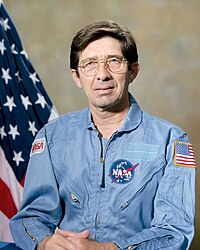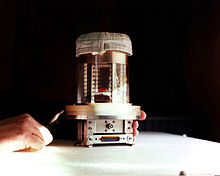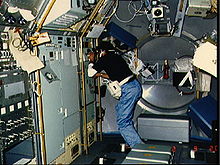Lodewijk van den Berg
| Lodewijk van den Berg | |
|---|---|

|
|
| Country: | United States |
| selected on | June 5, 1983 ( 3rd Spacelab group ) |
| Calls: | 1 space flight |
| Begin: | April 29, 1985 |
| Landing: | May 6, 1985 |
| Time in space: | 7d 0h 8min |
| retired on | May 6, 1985 |
| Space flights | |
|
|
Lodewijk van den Berg (born March 24, 1932 in Sluiskil , a village in the municipality of Terneuzen , Netherlands ) is an American scientist who took part in a space flight of a space shuttle . He was the first spaceman to be born in the Netherlands, but was no longer a Dutch citizen at the time .
Van den Berg studied chemical engineering at the Technical University of Delft from 1949 to 1961 . After graduation, he moved to the University of Delaware in the United States, where he received a master's degree in applied science and received his doctorate in 1974 , also in applied science.
Van den Berg was then offered a position at EG&G Corporation , a military supplier. Van den Berg was supposed to research crystal growth. However, since the company deals with militarily sensitive information, it became necessary for the native Dutchman van den Berg to become a US citizen in 1975 .
Astronaut activity
preparation
While at EG&G, van den Berg asked NASA for permission to conduct crystal growth experiments in space. NASA agreed, and van den Berg and his team constructed the Vapor Crystal Growth System (VCGS) for use on a space shuttle flight. NASA decided that it would be easier to turn a crystal growth expert into an astronaut than the other way around, and asked EG&G and van den Berg to make a list of eight people who could perform the experiments on a space flight. Van den Berg and his boss only came up with seven names. The boss added van den Berg's name to the list, but expected that van den Berg would be sorted out in NASA's first selection round due to his age, thick glasses and small stature. In the first round, however, four other applicants who did not meet the professional requirements were eliminated. Van den Berg also passed the physical tests, while two others dropped out because of possible heart problems. So van den Berg started training for the space mission together with Mary Johnston. In October 1984 van den Berg was selected for spaceflight and Johnston as a substitute.
Flight history
On April 29, 1985 van den Berg flew into space as a payload specialist on the space shuttle Challenger . The payload of the STS-51-B mission consisted of the Spacelab of the European Space Agency (ESA). 15 experiments were carried out, mainly to investigate liquids and materials in weightless space. Van den Berg was in charge of the Vapor Crystal Growth System he developed. Two monkeys and 24 rodents were also on board for biological studies. 14 experiments were successfully carried out. The science satellite NUSAT was also suspended.
After the space flight
After his space flight, van den Berg continued to grow crystals at EG&G. He later moved to Constellation Technology Corporation as chief scientist. Its crystals, mainly mercury iodide crystals, are used to manufacture precision detectors for radioactive radiation.
Private
Lodewijk van den Berg is married and has two children.
Honors
The asteroid (11430) Lodewijkberg was named after van den Berg .
See also
supporting documents
- Short biography of Lodewijk van den Berg at spacefacts.de
- NASA biography of Lodewijk van den Berg (English; PDF)
- Biography of Lodewijk van den Berg in the Encyclopedia Astronautica (English)
- Delft Integraal: Niet Wubbo maar Lodewijk van den Berg was de eerste PDF (Dutch)
- ↑ (11430) Lodewijkberg in the Small-Body Database of the Jet Propulsion Laboratory (English).
| personal data | |
|---|---|
| SURNAME | Berg, Lodewijk van den |
| BRIEF DESCRIPTION | American astronaut |
| DATE OF BIRTH | March 24, 1932 |
| PLACE OF BIRTH | Sluiskil , Netherlands |


